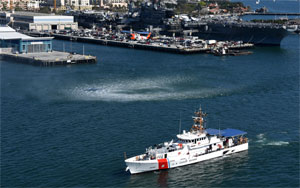In a familiar refrain, it was tough to find torches burning at Gulf Coast shipyards during the past year. Global oil markets remained lukewarm and demand for new offshore vessels followed suit. For yards able to diversify, ferries and excursion boats provided a welcome avenue to keep moving forward.
Suppressed demand for new offshore supply vessels (OSVs) and crew boats was not limited to North America. According to London-based VesselsValue, only one OSV or crew boat order was placed worldwide in the first six months of 2019 — a workboat for the British operator High Speed Transfers.
“In order to survive the oil price crash (of 2014) and subsequent downturn in the offshore markets, the industry has instead seen many vessels being sold for scrap and owners consolidating, which has led to many companies streamlining their fleets in order to reduce their operational costs,” VesselsValue analyst Olivia Watkins said in July.
The Gulf of Mexico led global regions in the number of OSVs laid up. At midyear, 390 were stacked, representing 38 percent of the fleet, according to VesselsValue. Limited drilling activity offshore exacerbated financial duress for operators, forcing consolidation and premature retirement for many vessels (see Susan Buchanan’s Crew/Supply roundup).
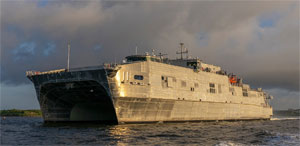 |
|
USNS Puerto Rico (EPF 11) is put through its paces during integrated builder’s and acceptance trials in August in the Gulf of Mexico. The expeditionary fast transport from Austal USA became the first ship in its class to undergo the combined testing. |
|
U.S. Navy photo |
But there also were some hopeful signs for future orders in the sector. According to Global Market Insights, the OSV market is forecast to grow at least 5.5 percent worldwide by 2024, reaching $66 billion.
“Shifting trends toward eco-friendly hydrocarbons on account of growing environmental concerns will fuel the offshore support vessel market,” the research company said in a September report. “Adoption of LNG (liquefied natural gas) by major fleet owners as a fuel subjected to the government norms toward reduction of marine emissions will foster the product penetration.”
That assertion is backed by the classification society DNV GL, which recently reported there are 184 LNG-fueled vessels on order worldwide, exceeding the 170 in operation. The primary driver is the International Maritime Organization’s 0.5 percent sulfur cap for marine fuels. It goes into effect on Jan. 1, 2020, spurring many shipowners to get on board with the upfront costs of investing in cleaner propulsion systems.
Another positive indicator is that offshore gas and oil development has again become economically competitive with onshore drilling, according to Mark Peterson, investor relations vice president at Oceaneering International. That bodes well for activity in the Gulf of Mexico, although the process of working through the OSV stacks likely will cap new orders in the near future.
“Most researchers expect offshore activity to increase modestly over the medium term, and we agree,” Peterson told American Ship Review. “While that’s helpful to vessel utilization, it isn’t likely to result in a lot of new building, which would require sustained levels of utilization.”
Gulf shipyards whose portfolios aren’t limited to vessels working the petroleum fields continued to deliver newbuilds through mid-2019. A range of orders for ferries, excursion boats, patrol boats and government vessels helped buoy Eastern Shipbuilding Group, VT Halter Marine, Metal Shark Boats, Gulf Craft and other yards that have been able to diversify their production. For those that haven’t, short-term prospects aren’t bright.
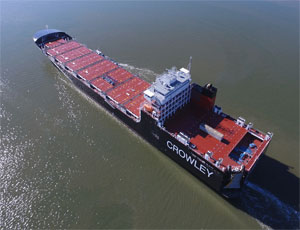 |
|
Taino is the second of two LNG-powered con-ros built by VT Halter Marine for Crowley Maritime Corp. The ship made its maiden voyage from Jacksonville, Fla., to Puerto Rico in January. |
|
Courtesy Crowley Maritime Corp. |
Big ships, big splash
Some of the biggest industry develop-ments in the past year occurred in a sector that many people don’t associate with American shipbuilding: large cargo ships. Philly Shipyard led the way with the delivery of two 850-foot containerships, and work continued at other yards on similar vessels destined for Jones Act service.
Last October, Philly delivered Daniel K. Inouye to Matson, following it up in March with the delivery of sister Kaimana Hila. Weighing in at more than 51,400 metric tons, the 3,600-TEU newbuilds are the largest containerships ever built in the United States. Both LNG-ready ships cater to Matson’s trade between the U.S. mainland and Hawaii.
Unfortunately for Philly, the Aloha-class boxships emptied the shipyard’s order book. With nothing else in the pipeline, the builder has laid off nearly all of its workforce.
“Currently, there is no shipbuilding or repair activity at the shipyard, and all production facilities are idle and both graving docks are empty,” the company reported at the end of the second quarter. “Today, Philly Shipyard employs approximately 80 people (down from 1,200 at the beginning of 2018). Philly Shipyard plans to keep a core group of employees to focus on efforts to secure new orders and transition the shipyard into a mix of commercial and government work.”
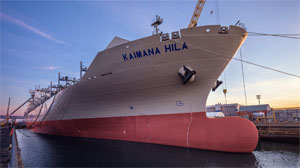 |
|
Philly Shipyard delivered the 3,600-TEU Kaimana Hila to Matson in March. The Aloha-class containership joined sibling Daniel K. Inouye, delivered by the shipyard in October, on the mainland-to-Hawaii run. |
|
Courtesy Office of Rep. Tulsi Gabbard |
That effort paid dividends in July with a contract from the U.S. Maritime Administration to repair and refit SS Antares, an Algol-class vehicle cargo ship owned by MarAd and managed by TOTE Services. The dry-dock overhaul began in August. Philly also announced in July that it had appointed Brian Leathers, formerly with Austal USA, as chief financial officer. Philly cited Leathers’ “deep government contracts experience.”
In December, VT Halter delivered Taino, the shipyard’s second container/roll-on/roll-off ship (con-ro) for Crowley Maritime that features LNG propulsion. The first Commitment-class ship, El Coqui, was delivered in July 2018. The Jones Act newbuilds are 720 feet long, 26,500 dwt, and can transport up to 2,400 TEUs at a cruising speed of 22 knots. Taino completed its maiden voyage from its home port in Jacksonville, Fla., to San Juan, Puerto Rico, in early January.
At Keppel AmFELS in Brownsville, Texas, work continued on a pair of LNG-powered containerships for Pasha Hawaii. In May, the keel was laid for the Ohana-class George III, and the first steel plates were cut for sister Janet Marie. The 774-foot U.S.-flagged ships will operate fully on LNG from their first day in service. They will join Pasha’s fleet in the mainland-to-Hawaii trade and are scheduled for delivery in 2020.
In addition to a reduced environmental footprint courtesy of LNG, Pasha said energy savings would be achieved with an advanced engine, an optimized hull form, and a high-efficiency rudder and propeller.
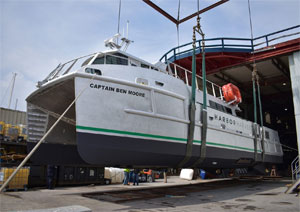 |
|
Captain Ben Moore is the third hybrid catamaran from Derecktor Shipyards. The 65-foot aluminum boat was built for Harbor Harvest, a Connecticut company that aims to relieve traffic congestion by transporting goods across Long Island Sound instead of around it. The vessel has a BAE Systems propulsion package with lithium-ion batteries. |
|
Courtesy Derecktor Shipyards |
“These Jones Act ships being built at Keppel will be among the most modern, fuel-efficient containerships in the world, and are living and breathing proof that we have the know-how and the can-do spirit to keep America a global leader in shipbuilding innovation,” said Matt Woodruff, chairman of the American Maritime Partnership.
In June, General Dynamics NASSCO launched the largest con-ro ever built in the U.S. — the 870-foot Lurline — for Matson. It is the first of two Kanaloa-class ships that the San Diego yard is building for the operator’s West Coast-to-Hawaii service.
Lurline is 870 feet long and weighs in at more than 50,000 metric tons. Upon delivery in late October it will become the largest ship in Matson’s fleet, surpassing Daniel K. Inouye. With a top speed of 23 knots, it also will be among the operator’s fastest ships.
Built on a 3,500-TEU platform, the con-ro will be able to accommodate 500 vehicles in addition to rolling stock and break-bulk cargo. Green features include EPA Tier 3 dual-fuel engines, a fuel-efficient hull form, double-skin fuel tanks and a freshwater ballast system.
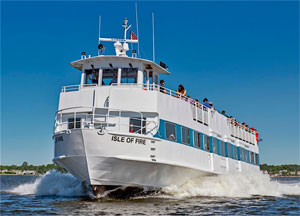 |
|
The 400-passenger Isle of Fire is the 10th newbuild from Blount Boats of Warren, R.I., for New York’s Fire Island Ferries. The shipyard is currently building two other ferries for operators in the Empire State. |
|
Courtesy Fire Island Ferries |
Headway for new training ships
Training ships at the nation’s maritime academies have been ripe for replacement for decades, with SUNY Maritime’s Empire State VI the oldest in the fleet at 57 years. Congress has allocated $600 million for two newbuilds, and in May the program to build five national security multi-mission vessels (NSMVs) gained an overseer: TOTE Services.
Under a contract from MarAd, TOTE will serve as vessel construction manager and will select a U.S. shipyard for the project. That will likely occur by the end of 2019, according to the agency. Delivery of the first ship in the series, for SUNY Maritime, is set for late 2022. Delivery of the second, for Massachusetts Maritime, is expected in 2023. Three more ships will follow for academies in Maine, Texas and California. Herbert Engineering of Annapolis, Md., is providing the design.
The NSMVs will have diesel-electric propulsion, two engine rooms (one for operations and the other for teaching) and accommodations for up to 600 cadets and 100 crew, faculty and support staff. Each ship will have eight classrooms, a full training bridge, laboratories and an auditorium.
As a “highly functional national asset” that can support federal disaster relief efforts, the ships also will be equipped with advanced hospital facilities, a helicopter landing pad, a roll-on/roll-off ramp, and the ability to berth up to 1,000 people, MarAd said.
The shipbuilder selected by TOTE clearly will be a big winner, but the project also is important to the overall shipyard industrial base, said Matthew Paxton, president of the Shipbuilders Council of America.
“While our industry cares immensely about America’s ability to build large Navy and Coast Guard vessels … it is equally important that we maintain and promote the construction of large oceangoing commercial vessels,” he said.

